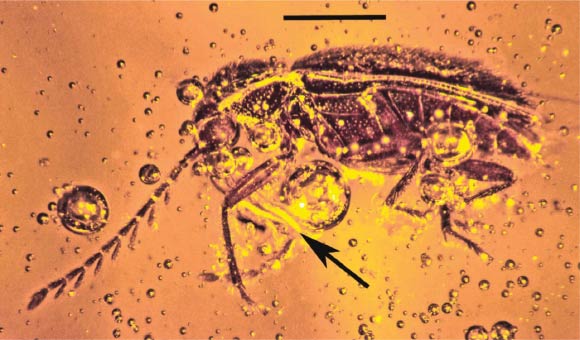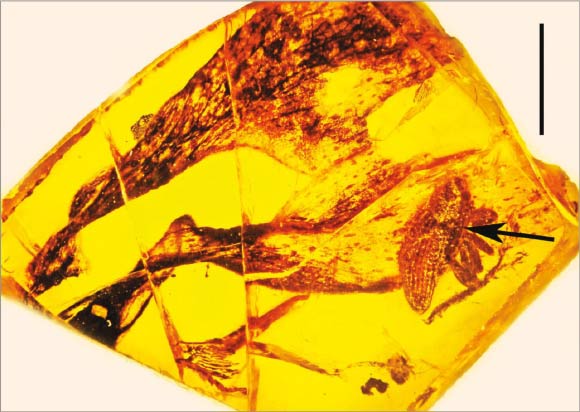Certain beetles are known to pollinate plants. New fossil evidence from Mexican and Dominican fossilized amber indicates that they were doing so 20 million years ago (Miocene epoch), according to Oregon State University scientist George Poinar, Jr.

Mexican amber ptilodactyline beetle with attached pollinium of Annulites mexicana (arrow). Scale bar - 0.4 mm. Image credit: George Poinar Jr.
The discovery is detailed in a paper published today in the journal American Entomologist.
“My paper points out that beetles may play a more important role in pollinating orchids than originally thought, and that they have been doing so for some 20 million years,” Dr. Poinar said.
In his paper, Dr. Poinar describes beetles found in chunks of Mexican and Dominican amber with orchid pollen in their mouthparts.
Some extant beetles use orchids for nectar, but no fossil evidence has ever been found showing beetles in the evolutionary past pollinating orchids – until now.
The first specimen was a hidden-snout beetle (subfamily Cryptorhynchinae) found in a piece of 20-45 million year old amber from the Dominican Republic.
This specimen had pollinaria from an orchid described as Cylindrocites browni attached to its thorax.
“The weevil (length - 4.0 mm) is a member of the Cryptorhynchini, a group known as the ‘hidden snout weevils’ because in repose, the beak is partly concealed against the thorax and between the front coxae,” Dr. Poinar explained.
“The larvae breed in stems or wood and the adults are known to visit flowers. Cryptorhynchinae were quite diverse in the Dominican amber forest.”
The other specimen was a toe-winged beetle (family Ptilodactylidae) that was found in a piece of 22-26 million year old Mexican amber.
This toe-winged beetle (1.4 mm in length) had pollinaria from an orchid described as Annulites mexicana attached to its mouthparts.

Dominican amber cryptorhynchid weevil with attached pollinarium (arrow) of Cylindrocites browni. Floral remains in background. Scale bar – 3 mm. Image credit: George Poinar Jr.
While other beetles are known to pollinate plants, no current-day hidden-snout beetles have been seen visiting orchid plants, and no current-day toe-winged beetles have been seen with pollinaria.
“The reason may lie in the beetles’ secretive behavior, which makes it difficult to collect data about them,” Dr. Poinar said.
“While no present-day cryptorhynchid weevils or ptilodactyline beetles are known to carry pollinaria, past and future collections of these and other beetles should be examined to search for attached pollinaria.”
“Orchids may have evolved beneficial associations with a much wider range of beetles and other insects than we thought possible.”
_____
George Poinar Jr. 2016. Beetles with Orchid Pollinaria in Dominican and Mexican Amber. American Entomologist 62 (3): 172-177; doi: 10.1093/ae/tmw055







